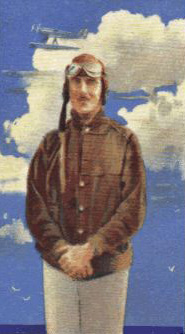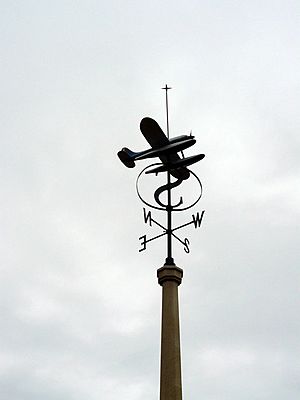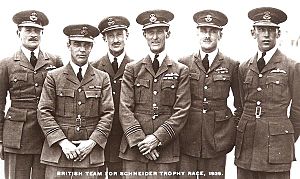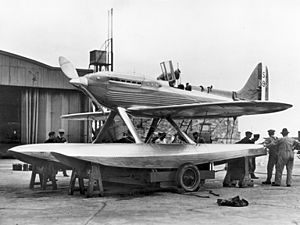George Stainforth facts for kids
Quick facts for kids
George Stainforth
|
|
|---|---|

Flight Lieutenant G H Stainforth (cigarette card)
|
|
| Born | 22 March 1899 Bromley, London, England |
| Died | 27 September 1942 (aged 43) Egypt |
| Buried |
Ismailia War Memorial Cemetery
|
| Allegiance | United Kingdom |
| Service/ |
British Army Royal Air Force |
| Rank | Wing Commander |
| Commands held | No. 89 Squadron RAF (1941–42) No. 600 Squadron RAF (1941) No. 30 Squadron RAF (1937) |
| Battles/wars | First World War Second World War |
| Awards | Air Force Cross |
George Hedley Stainforth (born March 22, 1899, died September 27, 1942) was a brave pilot in the Royal Air Force. He was the very first person in the world to fly an airplane faster than 400 miles per hour! This was a huge achievement for his time. He earned the rank of Wing Commander and was awarded the Air Force Cross for his amazing flying skills.
Contents
Early Life and Joining the RAF
George Stainforth grew up in England. His father, George Staunton Stainforth, was a lawyer. George went to two schools, Dulwich College and Weymouth College. He first joined the British Army, then later joined the Royal Air Force (RAF).
George Stainforth joined the RAF on March 15, 1923. After four years, he was promoted to flight lieutenant in 1928. He then joined a special group called the High Speed Flight. This team worked on making planes fly incredibly fast.
Breaking Air Speed Records
George Stainforth became famous for his record-breaking flights. He was part of the team that competed in the exciting Schneider Trophy races. These races were held to see which country could build the fastest seaplane.
The 1929 Schneider Trophy Race
In 1929, Stainforth was a pilot for the High Speed Flight team. He was supposed to fly the Gloster VI plane in the Schneider Trophy race. However, his plane had some technical problems and couldn't compete. His teammate, Henry Waghorn, won the race in a Supermarine S.6.
Even though he couldn't race, Stainforth still got to show off the Gloster VI's speed. The day after the race, he flew the Gloster VI over a special course. He reached a top speed of 351.3 miles per hour! His average speed over four runs was 336.3 miles per hour. This set a new world speed record for a short time.
The 1931 Schneider Trophy and 400 mph
Stainforth was also on the team for the 1931 Schneider Trophy race. This was a very important race because if Britain won it for the third time in a row, they would keep the trophy forever! The team succeeded, winning the competition outright.
After this big win, Stainforth got another chance to break the world airspeed record. He first flew a Supermarine S.6B plane, reaching 379 miles per hour. But during testing, his plane had a small accident and sank! Luckily, it was recovered the next day.
Stainforth then switched to another Supermarine S.6B. This plane had a super powerful 2,600 horsepower Rolls-Royce R engine. It used a special fuel mix of petrol, methanol, and ethyl. Starting this engine was tricky and even dangerous!
On September 29, 1931, Stainforth made his record attempt. His plane didn't have flaps, so it needed a very long runway on the water to take off. He flew perfectly over the timed course, going in opposite directions. He achieved an amazing average speed of 407.5 miles per hour! This made him the first person in the world to fly faster than 400 miles per hour. For this incredible feat, he received the Air Force Cross.
Stainforth later broke another unusual record. He flew a plane upside down for 12 minutes!
Career After High Speed Flight
After leaving the High Speed Flight team in 1935, Stainforth continued his impressive career. He was promoted to squadron leader in 1936. He served in Iraq as the leader of No. 30 Squadron RAF.
In 1940, during World War II, Stainforth worked with another famous pilot, Robert Stanford Tuck. They were tasked with comparing a captured German Messerschmitt Bf 109E plane with a British Supermarine Spitfire Mark II. Stainforth flew the Messerschmitt, and Tuck flew the Spitfire. They tested the planes in different ways, like flying level, diving, and turning, at various speeds and heights. This helped the RAF understand the enemy's aircraft better.
In October 1941, Stainforth became the leader of No. 89 Squadron RAF, a night fighter squadron. At the end of that year, his squadron moved to the Middle East. Sadly, on September 27, 1942, Wing Commander Stainforth was killed in action. He was flying a Bristol Beaufighter plane near the Gulf of Suez in Egypt. He was buried with full military honors in Ismailia, Egypt.
After his death, his friends put together a special collection of his achievements and memories. This collection is now kept at the Royal Air Force Museum in Hendon.
The Stainforth Trophy
The Stainforth Trophy was created in 1974 to honor Wing Commander George Hedley Stainforth. It celebrates his long and distinguished career as a pilot and RAF officer. The trophy was paid for by a woman named Mrs. Stella Sketch.
The Stainforth Trophy is awarded every year to the best-performing operational station in the RAF Strike Command. It is considered their most important trophy. Members of the Stainforth family still attend the presentation ceremony each year.
Trophy Design
The Stainforth Trophy was designed by Robin Beresford. It is made of silver and shows three supersonic aircraft. They are soaring into the sky with spiraling vapor trails. The artist also wanted to show how the achievements of the Schneider Trophy team led to better plane designs. For example, the Supermarine Spitfire, which was so important in Britain's victory in World War II, was developed from these fast planes.
The trophy's design also shows the Earth as seen from space. The vapor trails end in arrows, showing high-speed, high-altitude flight. They sweep outwards, suggesting that the sky is the only limit to what humans can achieve in the air. The design also includes a star and its orbit, representing science and the Royal Air Force motto, Per ardua ad astra (meaning "Through adversity to the stars").
Fun Facts
Cigarette Cards
George H. Stainforth's picture appeared on several cigarette card sets. These cards were popular collectibles back then. Some sets included:
- Lambert & Butler's Famous British Airmen & Airwomen
- Carreras: Famous Airmen and Airwomen (1936)
- Carreras: Famous British Fliers (1956)
- Park Drive cigarettes (Gallaher Ltd): Champions 1st series (1934)
Stainforth Weather Vane

A special weather vane was made in 1932 to remember Stainforth. It was given to Weymouth College, his old school. The weather vane celebrates his world air speed record from the year before.
The vane is made of hardwood covered in copper. It was first placed above the college chapel in 1932. But it was moved for safety when World War II started. Later, it was given to the local council and placed in Greenhill Gardens in May 1952.
In 1996, the weather vane had to be taken down. Years of sea spray and coastal winds had damaged it. But it has since been fixed and is now back in the gardens for everyone to see!





